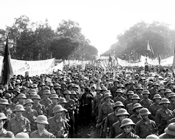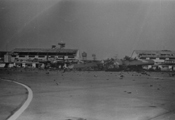April 30, 1975: The Fall of Saigon - 1975


Liberation of Saigon Celebrated--Soldiers of PRG and North Vietnamese troops are shown attending the rally staged in front of the Du Doc Lap (former presidential place) in Saigon on May 7th to celebrate the liberation of Saigon. During the rally, General Tran Van Tra, chairman of the Military Management Committee of PRG, was presented to South Vietnamese people.
(Lewis M. Stern Collection [VA027379])

AC 11g aircraft destroyed and damaged during A37 attack on the 28th April 1975 at 815H, Air Ops Building, Tau Sm Nhul Phot by Chuy of Intelligence Vietnamese Air Force
(William E. LeGro Collection [VA039224])
In January 1975, Phuoc Long fell to the communists. The South Vietnamese government had always believed that if the North Vietnamese violated the terms of the Paris Peace Accords the Americans would return with force to help them. President Thieu asked for more aid to help regain the lost territory, but unfortunately for South Vietnam, the time for massive American aid had passed. Congress sent a delegation to Vietnam to judge the situation, and while they did recommend an immediate increase in aid to South Vietnam, the situation continued to deteriorate and it became apparent that South Vietnam could not survive much longer.
The fall of Ban Me Thuot on March 10 affected the situation in two distinct ways. First, Paul Struharik, the U.S Province Representative for Darlac, and several American missionaries were captured in the defeat. Second, several Vietnamese employees of Air America were captured and executed by the North Vietnamese. The captured Americans, combined with the ARVN losses, convinced Congress to deny further aid to South Vietnam and to urge the Americans remaining in-country to plan for a final evacuation. The executions sparked a mass panic across South Vietnam, causing both civilians and military personnel to flee in the face of the communist army, often before a shot was even fired. As the panic continued, Thieu, fearing for his own safety, pulled the elite airborne rangers out of I and II Corps and moved them into Saigon to defend the capital. These actions destabilized the situation in the northern provinces of South Vietnam and allowed the North Vietnamese to take I and II Corps virtually unopposed.
On March 15, Pleiku, Kontum, and Darlac in the Central Highlands were abandoned by the senior military officers, leaving the civilians and remaining ARVN troops to find their own way to safety. Many of them trekked south to Nha Trang, most without any weapons or supplies for the journey, while communist troops continued to harass the fleeing refugees. The remaining ARVN troops defended the convoy to the best of their abilities, but 30,000 to 40,000 people were killed or died of starvation during the fifteen-day retreat. The press dubbed this event the "Convoy of Tears."
As March continued, Da Nang became choked with almost one million refugees and leaderless soldiers. Looting and panic rocked the city until the final evacuation on March 26 ??? 28. The Americans airlifted out their personnel and tried to evacuate as many of their Vietnamese workers as possible, but many were left behind. Ed Daly of World Airways flew a mission out of Saigon to the airfield at Da Nang in an effort to save more people. The first of his planes to land was mobbed so badly that it almost did not take off again. The pilot on the ground had to tell the others not to land because it was too dangerous. Desperate people began filling boats in the harbor in an effort to excape the city, and many left with nothing but the clothes on their backs. By the time the boats arrived in Cam Ranh Bay on April 1, many refugees had died of thirst.
At home, Americans watched their televisions with horror and anger as cities and towns with names that were familiar to them from their service in Vietnam were once again featured on the evening news. One by one, the cities began falling to the North Vietnamese: Qui Nhon and Nha Trang on April 1, Cam Ranh on April 3, Phan Rang on April 15, and Phan Thiet on April 19. The political situation in Saigon rapidly deteriorated and the North Vietnamese government made it clear that they would not negotiate with Thieu. On April 21, Thieu resigned the presidency with the hope that his successor would be able to negotiate better surrender terms with Hanoi. Over the next week the presidency changed hands twice, finally settling on General Duong Van Minh, also known as "Big Minh." On April 29, the North Vietnamese established positions outside of Saigon and began shelling Tan Son Nhut air base. Twenty-four hours later, the last of the Americans had left and the North Vietnamese came streaming into the city.
Vietnam Center & Sam Johnson Vietnam Archive
-
Address
Texas Tech University, Box 41041, Lubbock, TX 79409 -
Phone
(806)742-9010 -
Email
vnca@ttu.edu

